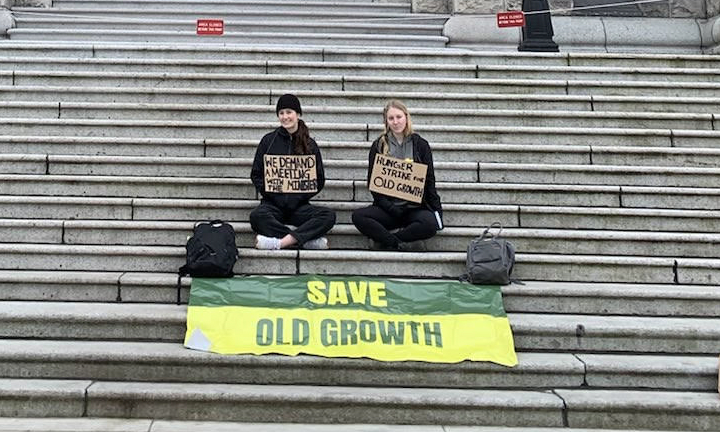Students went on strike to stop old forest logging in B.C.

On April 1, first-year UVic students Grace Charness and Jordana Pangburn joined a hunger strike for Save Old Growth.
Save Old Growth is a civil resistance campaign operating with the goal of halting all old growth logging in B.C. According to their website, the purpose of the hunger strike is to “[call] for a public meeting with the honorable Katrine Conroy, Minister of Forests, to discuss the protection of the last remaining 2.7 per cent of old growth forests in British Columbia.”
Charness and Pangburn joined five others across the province who also participated in the strike. One striker, Brent Eichler, is on an indefinite hunger strike which began on March 25.
“We also are doing this smaller hunger strike in solidarity and support with the other hunger strikers who were scattered throughout B.C.,” said Charness. “We [wanted] to bring more attention to them and their work with this cause.”
After participating for three and four days respectively, Charness and Pangburn feel their strike helped bring attention to the cause.
“We’ve been contacted and approached by several different media outlets,” said Charness. “I think it really helps that we’re two university students and [able] to be in Victoria and be on the steps of the legislature to help get this message out.”
While a hunger strike may seem like an extreme form of protest, Charness and Pangburn both believe that it is necessary.
“The Save Old Growth organization has been holding peaceful protests and marches and other forms of demonstrations for years now without really any sign of change,” said Charness. “They have found as an organization that there’s been the need to take more drastic measures, such as highway blockades and hunger strikes.”
Pangburn also added that although a hunger strike is a significant form of protest, it fits with the mission of the organization.
“The core value of Save Old Growth is nonviolent civil resistance and nonviolent action,” said Pangburn.
Charness and Pangburn got involved with Save Old Growth after meeting a member who was passing out pamphlets on campus. They saw the hunger strike as a way to get involved without putting themselves in a situation where they could be arrested.
While both Charness and Pangburn found the decision to participate easy, they did experience moments of doubt leading up to and throughout their hunger strike.
“I did get a bit nervous about the idea of going this long without food,” said Charness. “I know the health effects when you’re on a strike this short are minimal, but it’s still … something [I had] never done.” Charness also had moments of questioning if their actions would have any impact on the cause.
However, both began to feel the importance of their strike on the first day of sitting on the legislature steps.
“We were already having media come up to us and a lot of public attention,” said Charness. “Immediately we started to feel those effects, and that question of ‘what’s the reason that we’re doing this’ started to go away and the purpose of it became more clear.”
Charness was pleasantly surprised by the support they received from the public. Before the strike, Charness had concerns about encountering people opposed to the mission of Save Old Growth.
“There were those who didn’t really understand why it was necessary to do a hunger strike to support this cause,” said Charness. “But, we didn’t have anyone telling us they didn’t support what we were doing.”
Physically, both Pangburn and Charness experienced highs and lows throughout the strike. Headaches, stomach cramps, exhaustion, and lightheadedness were some of the symptoms they experienced. Pangburn also described struggling to stand for long but said the overall symptoms were more manageable than expected.
While Pangburn’s strike ended April 3 and Charness’ April 4, both have plans to continue working with Save Old Growth, including participating in highway blockades.
“No matter what movement we continue to do with Save Old Growth or what protests or anything we take part in in the future, they will all be nonviolent,” said Charness.
While some of the remaining 2.7 per cent of B.C.’s old growth trees are temporarily protected under various deferrals, Charness, Pangburn, and the rest of Save Old Growth will continue to call for stronger action.
“We’re looking for definitive change,” said Charness. “Not just deferrals or smaller policies, but the official end of the logging of old growth in B.C.”
The Martlet contacted the Ministry of Forests for a comment on the striker’s demands but did not hear back before publication.








